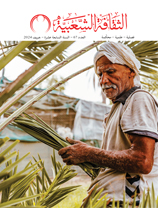Time and Place in Contemporary Bahraini Music
Issue 61

Dr. Rashid Najm
In our Bahraini dialect, the word ‘fai’ refers to a changing shadow, and the word ‘baraih’ is the plural of ‘braha’, which refers to a large area where people gather. This research examines the meanings of time and place in contemporary Bahraini songs and how these songs have become a way of preserving the memory of places that no longer exist and times that have receded in the light of progress and development.
The place is the human space that embraces customs, traditions and ideas and time is a fundamental dimension in monitoring the transformation of the functional dimension of the place as a result of the social view of the ever-changing reality of life. The good place is the space in which people are able to communicate thoughts, feelings and emotions. A person does not experience the usefulness of a place until his needs for security, ease of mobility, aesthetics, are met. Once these needs are met, people become able to interact with the place and build a connection with it.
Time, on the other hand, is a difficult concept to understand because we can perceive it mentally but cannot sense it physically. Yet, we can recognise its physical consequences. We cannot sense time unless it is associated with space and movement. The earth's rotation creates night and day while its movement around the sun creates the four seasons and their effects. Hence, time is the result of motion, and motion can only happen in a space.
The lyrics that Bahraini artists have chosen to sing since the late nineteenth and early twentieth centuries have reached us in the form of audio recordings, whether on CDs or tapes, circulated by well-known singers such as Mohammad bin Faris, Dahi bin Walid, Mohammed Zuwaid, and other artists of that generation. These singers were the pioneers of the Sawt artform. As for the second generation of singers that came after them, such as Yousif Foni, Abdullah Bu-Shaikha, Anbar, Ahmed Khalid and Ali Khalid, are considered the artists who modernized Bahraini songs.
The popular music style of that time was Sawt, pioneered by artist Mohammed Bin Faris. To complement the style of its melodies, the majority of the lyrics of Bahraini songs are from well-known Arabic poetry by great Arab poets. Their selection of lyrical texts represented their calibre of literary and poetic taste, and was primarily related to the poem's creative value, its fit with the melody, and how well the public will accept and relate to its lyrics.
Many of the lyrics describe time and place. The presence of these concepts within the context of a poetic or lyrical text provides them with a deeper semantic dimension since these words function as symbols of semantic intensity, and so they shift from their direct semantic meaning to a higher level of significance.
There are those who yearn for a bygone era, and they have an emotional attachment to it because it was a time marked by simplicity and ease of living, which reflects positively on spiritual tranquillity and mental peace. The present day is condemned for its harshness, complications and the increasing pace of events, particularly with regards to technological growth, which introduces new things with every sunrise.
On the other hand, there are those who have adapted to this time and who like modern life. They can see that the past, despite its simplicity and its harmony of time and place, does not match positive present-day developments in terms of health, education and speed of communication which lead to an accelerating pace of life and its negative affect on happiness. It is between this nostalgia and this adaptation to modern changes that the conflict of time and place reside.




































































